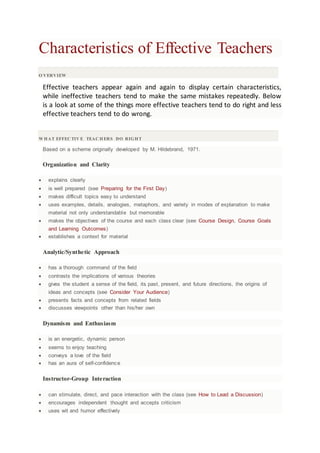
Characteristics of effective teachers
- 1. Characteristics of Effective Teachers O VERVIEW Effective teachers appear again and again to display certain characteristics, while ineffective teachers tend to make the same mistakes repeatedly. Below is a look at some of the things more effective teachers tend to do right and less effective teachers tend to do wrong. W HAT EFFEC TIV E TEAC H ERS DO RIGHT Based on a scheme originally developed by M. Hildebrand, 1971. Organization and Clarity explains clearly is well prepared (see Preparing for the First Day) makes difficult topics easy to understand uses examples, details, analogies, metaphors, and variety in modes of explanation to make material not only understandable but memorable makes the objectives of the course and each class clear (see Course Design, Course Goals and Learning Outcomes) establishes a context for material Analytic/Synthetic Approach has a thorough command of the field contrasts the implications of various theories gives the student a sense of the field, its past, present, and future directions, the origins of ideas and concepts (see Consider Your Audience) presents facts and concepts from related fields discusses viewpoints other than his/her own Dynamism and Enthusiasm is an energetic, dynamic person seems to enjoy teaching conveys a love of the field has an aura of self-confidence Instructor-Group Interaction can stimulate, direct, and pace interaction with the class (see How to Lead a Discussion) encourages independent thought and accepts criticism uses wit and humor effectively
- 2. is a good public speaker (see Speaking at the Hume Center for Writing and Speaking) knows whether or not the class is following the material and is sensitive to students’ motivation is concerned about the quality of his/her teaching Instructor-Individual Student Interaction is perceived as fair, especially in his/her methods of evaluation (see How to Evaluate Students) is seen by students as approachable and a valuable source of advice even on matters not directly related to the course (see Interacting with Students) W HAT LES S EFFEC TIV E TEAC HERS DO W RO NG Doing the right things with your teaching is of course critical but so is avoiding the wrong things. Richard M. Felder, North Carolina State University and Rebecca Brent, Education Designs, Inc., have come up with a list to the ten worst mistakes teachers make. They are summarized here in increasing order of badness. Further details and additional material can be found at Richard Felder’s Home Page. Mistake #10: When you ask a question in class, immediately call for volunteers. When you do this most students will avoid eye contact, and either you get a response from one of the two or three who always volunteer or you answer your own question Mistake #9: Call on students cold. If you frequently call on students without giving them time to think ("cold-calling"), the ones who are intimidated by it won't be following your lecture as much as praying that you don't land on them. Even worse, as soon as you call on someone, the others breathe a sigh of relief and stop thinking. Mistake #8: Turn classes into PowerPoint shows. Droning through lecture notes put into PowerPoint slides is generally a waste of time for everyone. Mistake #7: Fail to provide variety in instruction. Effective instruction mixes things up: boardwork, multimedia, storytelling, discussion, activities, individual assignments, and group work (being careful to avoid Mistake #6). The more variety you build in, the more effective the class is likely to be. Mistake #6: Have students work in groups with no individual accountability. The way to make group work work is cooperative learning, an exhaustively researched instructional method that effectively promotes development of both cognitive and interpersonal skills Mistake #5: Fail to establish relevance. To provide better motivation, begin the course by describing how the content relates to important technological and social problems and to whatever you know of the students' experience, interests, and career goals, and do the same thing when you introduce each new topic. Mistake #4. Give tests that are too long. If you want to evaluate your students' potential to be successful professionals, test their mastery of the knowledge and skills you are teaching, not their problem-solving speed. Mistake #3: Get stuck in a rut. Things are always happening that provide incentives and opportunities for improving courses. This is not to say that you have to make major revisions in your course every time you give it-you probably don't have time to do that, and there's no reason to. Rather, just keep your eyes open for possible improvements you might make in the time available to you. Mistake #2. Teach without clear learning objectives. A key to making courses coherent and tests fair is to write learning objectives-explicit statements of what students should be able to do if
- 3. they have learned what the instructor wants them to learn-and to use the objectives as the basis for designing lessons, assignments, and exams. Mistake #1. Disrespect students. If you give students a sense that you don't respect them, the class will probably be a bad experience for everyone no matter what else you do, while if you clearly convey respect and caring, it will cover a multitude of pedagogical sins you might commit. NO TES Richard M. Felder, North Carolina State University and Rebecca Brent, Education Designs, Inc. M. Hildebrand, R.C. Wilson, and E.R. Dienst, Evaluating University Teaching. (Berkeley: UC Berkeley, Center for Research and Development in Higher Education, 1971)
